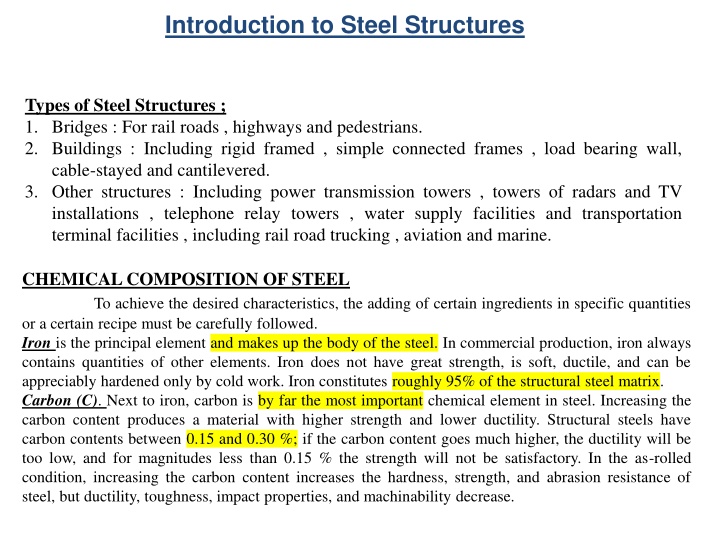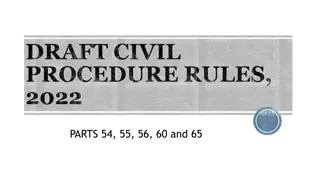
Chemical Composition of Steel Structures
Explore the chemical composition of steel structures, including the role of elements like carbon, manganese, and more in achieving desired properties. Learn about the impact on strength, ductility, and other characteristics crucial for various types of steel structures such as bridges, buildings, and other applications.
Download Presentation

Please find below an Image/Link to download the presentation.
The content on the website is provided AS IS for your information and personal use only. It may not be sold, licensed, or shared on other websites without obtaining consent from the author. If you encounter any issues during the download, it is possible that the publisher has removed the file from their server.
You are allowed to download the files provided on this website for personal or commercial use, subject to the condition that they are used lawfully. All files are the property of their respective owners.
The content on the website is provided AS IS for your information and personal use only. It may not be sold, licensed, or shared on other websites without obtaining consent from the author.
E N D
Presentation Transcript
Introduction to Steel Structures Types of Steel Structures ; 1. Bridges : For rail roads , highways and pedestrians. 2. Buildings : Including rigid framed , simple connected frames , load bearing wall, cable-stayed and cantilevered. 3. Other structures : Including power transmission towers , towers of radars and TV installations , telephone relay towers , water supply facilities and transportation terminal facilities , including rail road trucking , aviation and marine. CHEMICAL COMPOSITION OF STEEL To achieve the desired characteristics, the adding of certain ingredients in specific quantities or a certain recipe must be carefully followed. Iron is the principal element and makes up the body of the steel. In commercial production, iron always contains quantities of other elements. Iron does not have great strength, is soft, ductile, and can be appreciably hardened only by cold work. Iron constitutes roughly 95% of the structural steel matrix. Carbon (C). Next to iron, carbon is by far the most important chemical element in steel. Increasing the carbon content produces a material with higher strength and lower ductility. Structural steels have carbon contents between 0.15 and 0.30 %; if the carbon content goes much higher, the ductility will be too low, and for magnitudes less than 0.15 % the strength will not be satisfactory. In the as-rolled condition, increasing the carbon content increases the hardness, strength, and abrasion resistance of steel, but ductility, toughness, impact properties, and machinability decrease.
Manganese (Mn). Manganese appears in structural steel grades in amounts ranging from about 0.50 to 1.70 percent. It has effects similar to those of carbon and it is next in importance to carbon as an alloying element. It has a strengthening effect upon iron and also a beneficial effect upon steel by increasing its response to heat treatment. Aluminium (Al) is one of the most important deoxidizers in the material and also helps form a more fine-grained crystalline structure. It may be used alone as in low carbon steels, or more commonly in conjunction with other deoxidizers. Chromium (Cr) it is primarily used to increase the corrosion resistance of the material, and for that reason often occurs in combination with nickel and cooper. Chromium steels maintain strength at elevated temperatures. Nickel (Ni) enhances the low-temperature behaviour of the material by improving the fracture toughness. It is used in conjunction with chromium and stainless steels. Silicon (Si). Along with aluminium, silicon is one of the principal deoxidizers for structural steels. In amounts up to 2.5% it increases the hardenability of steels. Vanadium (V) is a mild deoxidizer, and its addition to steel results in a fine grain structure, which is maintained at high temperature. Vanadium steels have improved fatigue values and excellent response to heat treatment. Copper (Cu) is another of the primary corrosion resistance elements. It is typically found in amounts not less than 0.2 %. Molybdenum (Mo) has a pronounced effect in the promotion of hardenability. It raises the coarsening temperature of steel, increases the high-temperature strength, improves the resistance to creep, and enhances the corrosion resistance of stainless steels. Phosphorus (P) strengthens steel but reduces its ductility. It improves the machinability of high-sulphur steels and under some conditions may confer some increase in corrosion resistance. Sulphur (S) added to steel increases machinability. Because of its tendency to segregate, sulphur may decrease the ductility of low-carbon drawing steel. Its detrimental effect in hot rolling is offset by the manganese. Titanium (Ti) is an extremely effective carbide former and is used in stainless steels to stabilize the steel by holding carbon in combination. In low-alloy structural steels its use in combination with other alloys promotes fine grain structure and improves the strength of the steel in the as-rolled condition.
Weldability of structural steels All currently available structural steels are weldable, although some certain processes must be used for certain steel types. It is important that the structural engineer be able to asses whether a given grade of steel is weldable or not. This is crucial in the event that all records of the original delivery have been lost, and the chemical composition has been established through testing. Although a number of methods are available, the simplest one determines the carbon equivalent (Ce) of the steel, and compares it to a certain limit: + + + + Mn Si Cr Mo V Ni Cu = + + + 5 . 0 Ce C 6 5 15 where Mn, Si, etc are the percentages of the respective elements in the grade at hand. Good weldability is virtually assured if the equation is satisfied. Although certain steel are easier to weld than others, it is not correct to state that any particular type cannot be welded. If the steel requires a very expensive welding procedure bolted or other kinds of mechanical fastening will generally be preferable.
Types of Structural Steel Structural steels used for construction purpose are generally grouped into several major American Society of Testing and Materials (ASTM) classifications: Carbon Steels (ASTM A36M, ASTM A529M, ASTM 709M) In addition to iron, the main ingredients of this category of steels are carbon (maximum content D 1:7%) and manganese (maximum content D 1:65%), with a small amount .< 0:6%/ of silicon and copper. Depending on the amount of carbon content, different types of carbon steels can be identified: Low carbon steel carbon content < 0:15% Mild carbon steel carbon content varies from 0.15 to 0.29% Medium carbon steel carbon content 0.30 to 0.59% High carbon steel carbon content 0.60 to 1.70% The most commonly used structural carbon steel has a mild carbon content. It is extremely ductile and is suitable for both bolting and welding. ASTM A36M is used mainly for buildings. ASTM A529M is occasionally used for bolted and welded building frames and trusses. ASTM 709M is used primarily for bridges. High Strength Low Alloy Steels (ASTM A441M, ASTM A572M) These steels possess enhanced strength as a result of the presence of one or more alloying agents such as chromium, copper, nickel, silicon, vanadium, and others in addition to the basic elements of iron, carbon, and manganese. Normally, the total quantity of all the alloying elements is below 5% of the total composition. These steels generally have higher corrosion-resistant capability than carbon steels. A441 steel was discontinued in 1989; it is superseded by A572M steel.
Corrosion-Resistant High Strength Low Alloy Steels (ASTM A242M, ASTM A588M) These steels have enhanced corrosion-resistant capability because of the addition of copper as an alloying element. Corrosion is severely retarded when a layer of patina (an oxidized metallic film) is formed on the steel surfaces. The process of oxidation normally takes place within 1 to 3 years and is signified by a distinct appearance of a deep reddish-brown to black coloration of the steel. For the process to take place, the steel must be subjected to a series of wetting-drying cycles. These steels, especially ASTM 588, are used primarily for bridges and transmission towers (in lieu of galvanized steel) where members are difficult to access for periodic painting. Quenched and Tempered Alloy Steels (ASTM A852M, ASTM A514M, ASTM A709M) The quantities of alloying elements used in these steels are in excess of those used in carbon and low alloy steels. In addition, they are heat treated by quenching and tempering to enhance their strengths. These steels do not exhibit well-defined yield points. Their yield stresses are determined by the 0.2% offset strain method. These steels, despite their enhanced strength, have reduced ductility.
Stress-Strain Behavior of Structural Steel Structural steel is an important construction material. It possesses attributes such as strength, stiffness, toughness, and ductility that are very desirable in modern constructions. Strength is the ability of amaterial to resist stresses. It is measured in terms of the material s yield strength, Fy , and ultimateor tensile strength, Fu. For steel, the ranges of Fy and Fu ordinarily used in constructions are 36 to50ksi (248 to 345 MPa) and 58 to 70 ksi (400 to 483 MPa), respectively, although higher strengthsteels are becoming more common. Stiffness is the ability of a material to resist deformation. It ismeasured as the slope of the material s stress- strain curve. With reference to the hereunder figure in whichuniaxial engineering stress-strain curves obtained from coupon tests for various grades of steels are shown, it is seen that the modulus of elasticity, E, does not vary appreciably for the different steelgrades. Therefore, a value of 29,000 ksi (200 GPa) is often used for design.
Toughness is the ability ofa material to absorb energy before failure. It is measured as the area under the material s stress-straincurve. As shown in the figure above most (especially the lower grade) steels possess high toughness whichis suitable for both static and seismic applications. Ductility is the ability of a material to undergolarge inelastic, or plastic, deformation before failure. It is measured in terms of percent elongationor percent reduction in area of the specimen tested in uniaxial tension. For steel, percent elongationranges from around 10 to 40 for a 2-in. (5-cm) gage length specimen. Ductility generally decreaseswith increasing steel strength. Ductility is a very important attribute of steel. The ability of structuralsteel to deform considerably before failure by fracture allows an indeterminate structure to undergostress redistribution. Ductility also enhances the energy absorption characteristic of the structure, which is extremely important in seismic design.
Merits of Steel Construction 1. The reliability of steel construction are due to its consistency in properties. Better quality control because of its factory made structure shapes. e.g. if different samples are taken from the same type of steel and tested in the laboratory for its yield stress, ultimate stress and elongation, the variation is quite less as compared to the concrete & wooden samples where the stress variation is quite enormous. In the derivation of formulae the assumption made are satisfied because of the homogeneous and elastic properties of the steel material. Reliable in Character 2. Industrial in Behavior Rolled steel shapes are obtained from Rolling Mills and due to their fabrication in the industries their properties in construction will not much differ. There is less manual error as the members are fabricated & cut in the factories and then assembled at site; there is not much variation in behavior. 3. Quick in Construction Rolled steel as well as cold formed section are available in the market. The cutting of member section are done in factories and assembling is partially made in the factory and partially at site by rivets, bolts or welds, as the case may be. The construction time of the steel building is comparatively much less as compared to concrete structure whose construction is made in site or by prefabricated units
4. High Strength and Light Weight Nature Steel behaves closer to design assumptions than most of the other materials because it follows Hooke s law up to fairly high stresses. The stress produced remains proportional to the strain applied or the stress- strain diagram remains a straight line. The steel sections do not crack or tear before ultimate load and hence the moments of inertia of a steel structure can be definitely calculated. 5. Uniformity, Durability and Performance Durability means long life of a structure. Steel is a very homogeneous and uniform material. It satisfies the basic assumptions of most of the analysis and design formulas. If properly maintained by painting, etc., the properties of steel do not change appreciably with time. Hence, steel structures are more durable. 6. Elasticity High strength of steel /unit weight (e.g. 77kN/m3 & conc. 23.6 kN/in) will mean that dead load will become lesser. These loads are the bigger part of the total load of the structure. This is experienced in large span bridges & tall buildings and structure having poor foundation conditions.
7. Ductility and Warning before Failure The property of a material by which it can withstand extensive deformation without failure under high tensile stresses is said to be its ductility. Mild steel is a very ductile material. The percentage elongation of a standard tension test specimen after fracture can be as high as 25 to 30%. This gives visible deflections or evidence of impending failure in case of overloads. The extra loads may be removed from the structure to prevent collapse. Even if collapse does occur, time is available for occupants to vacate the building. In structural members under normal loads, high stress concentrations develop at various points. The ductile nature of the usual structural steels enable them to yield locally at those points, thus redistributing the stresses and preventing premature failure.
8. Addition to Existing Structures Additions to existing steel structures are very easy to be made. Connections between new and existing structures can be employed very effectively. New bays or even entire new wings of buildings can be added to existing steel frame buildings, and steel bridges may often be widened 9. Possible Reuse Steel sections can be reused after a structure is disassembled 10. Water Tight and Air Tight Construction Steel structures provide completely impervious construction. Structures like reservoirs, oil pipes, gas pipes, etc., are preferably made from structural steel.
11. Long Span Construction High-rise buildings, long span bridges and tall transmission towers are made up of structural steel. Industrial buildings up to a span of 90 m can be designed by plate girders or trusses. Bridge spans up to 260 m are made with plate girders. For through truss bridges, spans of 300 m have been used 12. Temporary Construction For temporary structures, steel construction is always preferred. Army constructions during war are mostly made out of structural steel. The structures may be disassembled by opening few bolts, component parts are carried to new places and the structure is easily reassembled.
Demerits of Steel Construction 1. High Maintenance Costs and Corrosion Most steels are susceptible to corrosion when freely exposed to air and water and must therefore be periodically painted. This requires extra cost and special care. The use of weathering steels, in suitable design applications, tends to eliminate this cost. If not properly maintained, steel members can loose 1 to 1.5 mm of their thickness each year. Accordingly such constructions can loose weight up to 35% during their specified life and can fail under the external loads.
2. High Fireproofing Cost Although steel members are incombustible, their strength is tremendously reduced at temperatures prevailing in fires. At about 400 C, creep becomes much more pronounced. Creep is defined as plastic deformation under a constant load for a long period of time. This produces excessively large deflections / deformations of main members forcing the other members to higher stresses or even to collapse. Steel is an excellent conductor of heat and may transmit enough heat from a burning compartment of a building to start fire in other parts of the building. Extra cost is required to properly fire proof the building
3. Susceptibility to Buckling Buckling is a type of collapse of the members due to sudden large bending caused by a critical compressive load. The steel sections usually consist of a combination of thin plates. Further, the overall steel member dimensions are also smaller than reinforced concrete members. If these slender members are subjected to compression, there are greater chances of buckling. Sometimes steel, when used for columns, is not very economical because considerable material has to be used merely to stiffen the columns against buckling.
4. High initial Costs / Less Availability In few countries, Iraq is one such example, steel is not available in abundance. Hence, its initial cost is very high compared with the other structural materials. This is the most significant factor that has resulted in the decline of steel structures in these countries. 5. Aesthetics For certain types of buildings, the steel form is architecturally preferred. However, for majority of residential and office buildings, steel structures without the use of false ceiling and cladding are considered to have poor aesthetic appearance. A considerable cost is to be spent on such structures to improve their appearance. Cladding is a covering of metal, concrete, plastic or timber put on the surface of a structural member to completely encase it. The cladding not only protects the member but also improves its appearance.
AISC Methods of Design There are two methods of structural design of structural steel: 1. Allowable Stress Design (ASD) The ASD method has been around for many decades and is still in use today. As with wood and other materials that also use this method, it is based on the premise that the allowable stress must be greater than the actual anticipated stress. It is based on the 9th edition of the AISC Manual of Steel Construction ASD, 1989. ASD Manual 9th ed. (1989)
2. Load and Resistance Factor Design (LRFD) This is the method that will be used in the design of structuralsteel members for this course. The LRFD method is relatively new the first edition of LRFD Manual of Steel Construction was in 1986 (the 2nd edition issued in 1999). It is based on a statistical approach of applying load factors to the anticipated service loads and selecting members such that the ultimate strength of the members exceeds the factored loads. The method is a bit more complicated and is not as widely used (yet) as the ASD method. However, design by the LRFD typically yields lighter- weight members and is therefore more efficient. This method is gaining increased support by architects and engineers and will most likely replace the ASD method. LRFD Manual 2nd ed. (1999)
Philosophies of Design A. Working Stress Design (Allowable Stress Design), widely known as (ASD) used for over 100 years. B. Limited States Design (Load & Resistance Factor Design) also known as (LRFD) first introduced in 1986. A limit state means A set of conditions at which a structure ceases to fulfill its intended function . Two types of limit states exist, these are: - Safety (Strength). - Serviceability (Deformation).
Assume load effects on structures = Q Assume Resistance to these loads = R Establishing frequency distribution for (Q) & (R): Frequency Resistance R, Load Q Frequency distribution of load Q Q and resistance R R. Thus always Rm > Qm, and the ratio of R/Q defines the Factor of Safety , such: R Q = Factor of Safety (F.S.).
AISC - Load & Resistance Factor Design Let ( Let ( ) = Strength Reduction Factor (Due to material and / or construction) ) = Overload ( Magnifying ) Factors ( Due to unexpected conditions). (i i = type of loading) R iQi This approach was presented in the ASCE-7, and was adopted by the AISC-LRFD of 1986.
Allowable Stress Design (ASD): suppose R is the reduction in resistance. suppose Q is the increase in loading. = + R R Q Q Q R Q = + 1 1 R Q R ( ( ) ) Q + Q 1 4 . 0 + 1 4 . 1 R = = = = . 1 = . . 67 F S 1 1 . 0 15 . 0 85 Q R R Load & Resistance Factor Design (LRFD) 1.4 D = 0.90 R (First load case) 1.56 D = R LRFD F.S. = R/D = 1.56 LRFD, compared to: F.S. = R/Q = 1.67 ASD






















